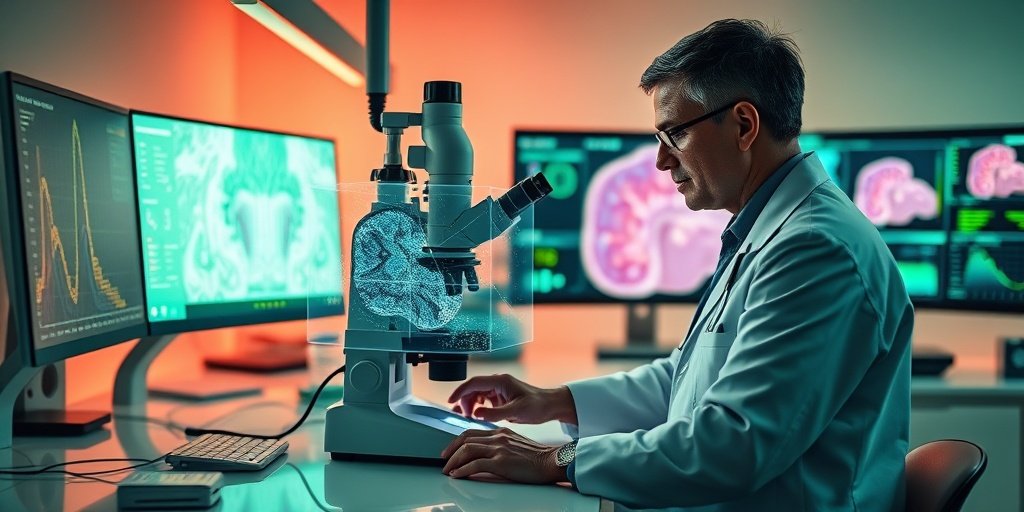⚡ Quick Summary
Recent advancements in computational nephropathology highlight the integration of artificial intelligence (AI) and deep learning into pathology, enhancing the analysis of histopathological images. These innovations promise to improve precision, reproducibility, and efficiency in kidney diagnostics.
🔍 Key Details
- 📊 Focus Area: Nephropathology
- 🧩 Methodologies: Quantitative nephropathology (pathomics), deep learning-based image classification, automated decision support systems
- ⚙️ Technologies: AI and deep learning techniques
- 🏆 Challenges: Technological, regulatory, ethical issues, and data privacy concerns
🔑 Key Takeaways
- 🤖 Computational pathology is revolutionizing the field of nephropathology.
- 💡 AI and deep learning facilitate high-throughput analysis of histopathological images.
- 📈 Pathomics offers a quantitative approach to understanding kidney pathology.
- 🔍 Automated systems can standardize reporting and improve diagnostic accuracy.
- ⚠️ Implementation challenges include data privacy and environmental sustainability.
- 🌟 Future developments could further transform kidney pathology, potentially coining the term “kidnAI pathology.”

📚 Background
The field of pathology has traditionally relied on the qualitative assessments of pathologists, which can be subjective and inconsistent. With the emergence of computational methods, particularly in nephropathology, there is a significant opportunity to enhance diagnostic accuracy and efficiency. The integration of AI and deep learning into pathology workflows is paving the way for a new era of precision medicine.
🗒️ Study
The article provides a comprehensive overview of the advancements in computational nephropathology, focusing on the integration of novel analytical methods. It discusses various methodologies, including quantitative nephropathology and deep learning techniques, while also addressing the strengths and limitations of these approaches.
📈 Results
The findings indicate that computational pathology can significantly enhance the analysis of kidney tissues, leading to improved diagnostic outcomes. The use of AI and deep learning has shown promise in automating the analysis of histopathological images, thereby increasing efficiency and reproducibility in diagnostics.
🌍 Impact and Implications
The implications of these advancements are profound. By integrating computational methods into nephropathology, we can expect a transformation in how kidney diseases are diagnosed and treated. This shift not only enhances patient care but also sets the stage for more standardized and objective assessments in pathology.
🔮 Conclusion
The advancements in computational nephropathology signify a pivotal moment in the field, with the potential to redefine kidney pathology through the integration of AI and deep learning. As we move forward, addressing the challenges of implementation will be crucial to fully realize the benefits of these technologies. The future of nephropathology is bright, and we eagerly anticipate further innovations in this exciting area!
💬 Your comments
What are your thoughts on the integration of AI in nephropathology? We would love to hear your insights! 💬 Share your comments below or connect with us on social media:
Advances in Computational Nephropathology.
Abstract
Pathology relies on pathologists’ qualitative assessment and semi-quantitative measures to characterize the structural and molecular alterations of tissues. Novel analytical methods and recent advances in the computational field, particularly in artificial intelligence (AI) and deep learning in pathology, termed computational pathology, have led to widespread applications and advancement in research. Integrating computational approaches into the digital pathology workflow can facilitate the automated, high-throughput analysis of histopathological images thereby improving precision, reproducibility, and efficiency in pathology diagnostics. We provide a comprehensive overview of the advancements and applications of computational pathology, specifically in nephropathology. We discuss widely adopted methodological approaches, highlighting their respective strengths and limitations, including quantitative nephropathology (i.e., pathomics), deep learning-based image classification and regression, and non-image applications, e.g., automated decision support systems for standardizing the reporting of current consensus classifications. Despite the promising potential of these approaches, several challenges remain for successful implementation in routine clinical practice. We highlight technological, regulatory and ethical challenges such as computational infrastructure, data privacy, and considerations of environmental sustainability. Looking towards the future, we envisage potential developments which could further transform the field. We are entering a new exciting era, where computational methods are reshaping and redefining kidney pathology, perhaps also renaming our field to “kidnAI” pathology.
Author: [‘Hölscher DL’, ‘Bülow RD’, ‘Strauch M’, ‘Boor P’]
Journal: Kidney Int
Citation: Hölscher DL, et al. Advances in Computational Nephropathology. Advances in Computational Nephropathology. 2025; (unknown volume):(unknown pages). doi: 10.1016/j.kint.2025.06.029